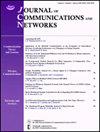A physical air-to-ground modeling method with dynamic investigations for integrated sensing and communication
IF 3.2
3区 计算机科学
Q2 COMPUTER SCIENCE, INFORMATION SYSTEMS
引用次数: 0
Abstract
Integrated sensing and communication (ISAC) is one of the key technologies in the sixth-generation (6G) wireless communication network. Unmanned aerial vehicles (UAVs) are essential for their flexible deployment, wide coverage, and high mobility. However, these attributes pose challenges for channel research. This paper presents a novel physical communication model for 6G ISAC in multiple-input multiple-output (MIMO) air-to-ground wireless channels. Here, the direct propagation link between the UAV transmitter and vehicle receiver is obstructed by buildings, hindering successful signal transmission. To address this, we propose employing double intelligent reflecting surfaces (IRSs) to assist signal transmission, forming the propagation links with either double or single IRSs along with the non-line-of-sight (NLoS) path. We investigate the complex channel impulse responses (CIRs) of these links considering multipath effects and derive the complete channel matrix. Additionally, we analyze the statistical properties of the communication model across various parameters. Leveraging these derivations, we illustrate the propagation characteristics of the MIMO UAV-to-vehicle communication model empowered by double IRSs. Simulation results highlight the superior channel characteristics of double- IRSs compared to single-IRSs, underscoring the significance of integrating double IRSs into the UAV-to-vehicle channel model.用于综合传感与通信的具有动态调查功能的空对地物理建模方法
综合传感与通信(ISAC)是第六代(6G)无线通信网络的关键技术之一。无人飞行器(UAV)因其部署灵活、覆盖范围广和高机动性而至关重要。然而,这些特性给信道研究带来了挑战。本文针对多输入多输出(MIMO)空对地无线信道中的 6G ISAC 提出了一种新型物理通信模型。在这种情况下,无人机发射器和飞行器接收器之间的直接传播链路会受到建筑物的阻挡,从而阻碍信号的成功传输。为解决这一问题,我们建议采用双智能反射面(IRS)来辅助信号传输,通过双或单 IRS 与非视线(NLoS)路径形成传播链路。考虑到多径效应,我们研究了这些链路的复杂信道脉冲响应(CIR),并推导出完整的信道矩阵。此外,我们还分析了不同参数下通信模型的统计特性。利用这些推导,我们说明了由双 IRS 支持的 MIMO 无人机到车辆通信模型的传播特性。仿真结果表明,与单IRS相比,双IRS具有更优越的信道特性,强调了将双IRS集成到无人机到车辆信道模型中的重要性。
本文章由计算机程序翻译,如有差异,请以英文原文为准。
求助全文
约1分钟内获得全文
求助全文
来源期刊
CiteScore
6.60
自引率
5.60%
发文量
66
审稿时长
14.4 months
期刊介绍:
The JOURNAL OF COMMUNICATIONS AND NETWORKS is published six times per year, and is committed to publishing high-quality papers that advance the state-of-the-art and practical applications of communications and information networks. Theoretical research contributions presenting new techniques, concepts, or analyses, applied contributions reporting on experiences and experiments, and tutorial expositions of permanent reference value are welcome. The subjects covered by this journal include all topics in communication theory and techniques, communication systems, and information networks. COMMUNICATION THEORY AND SYSTEMS WIRELESS COMMUNICATIONS NETWORKS AND SERVICES.

 求助内容:
求助内容: 应助结果提醒方式:
应助结果提醒方式:


